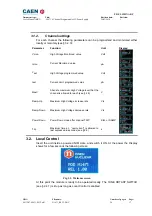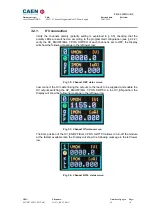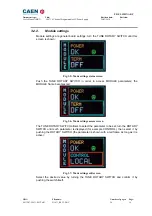
P R E L I M I N A R Y
Document type:
Title:
Revision date:
Revision:
User's Manual (MUT)
N1471 4 Channel Programmable HV Power Supply
24/03/2010
1
NPO:
Filename:
Number of pages:
Page:
00112/07:N1471.MUTx/01 N1471_REV1.DOC
38
28
3.4.1.2. RS232 communication
Fig. 3.29: RS232 communication diagram
In order to control the module via RS232 it is necessary to use the module’s COMM IN
port (refer to § 2.4.2 for RS232 signals) and to follow adaptation instructions (see
§ 4.2.2).
The connection can be performed via terminal emulator, such as HyperTerminal,
configured as follows:
-
baud rate 9600 (the same set on the N1471! See § 3.2.2)
-
Data bits: 8
-
Parity:
none
-
stop bit: 1
-
Flow control: Xon Xoff
It is also possible to build a daisy chain of up to 32 N1471’s, with the first module
connected to the PC RS232 port and the subsequent ones daisy chained through the
COMM IN/OUT, as explained in § 3.4.1.3; in this case communication with the chained
modules is achieved through the USB - RS485 Communication Protocol, see § 3.5. All
modules must be assigned a LOCAL BUS ADDRESS (see § 3.1.1) different from one
another and the last one must be terminated (see § 4.2.1).
3.4.1.3. RS485 communication
Fig. 3.30: RS485 communication diagram
The COMM IN / OUT connectors implement a RS485 type LOCAL BUS which allows to
build a 32 modules daisy chain. This can be achieved through the following steps:
−
Connect the connector OUT of a module to corresponding the IN connector of the
next one
−
Assign to each module a different address (LOCAL BUS ADDR); see § 3.1.1
−
Ensure that the LOCAL BUS BIT RATE is the same for all modules; see § 3.1.1
−
Terminate the first and the last module in the chain (see § 4.2)
The module control can be done in one of the following ways:











































